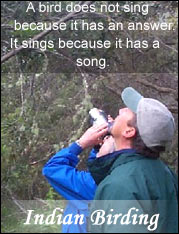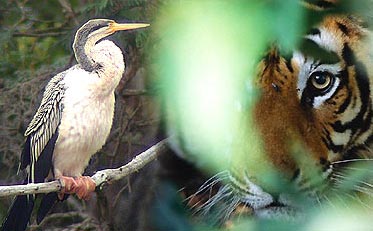 |
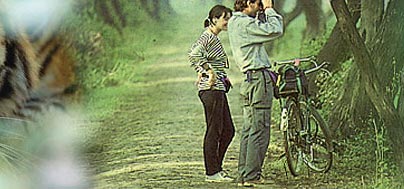 |
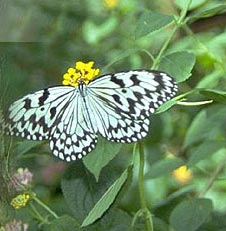 |
||
|
||||
Wildlife
Tours In India
Extensive Tiger Tour of North India
Duration : 16 Nights & 17 Days
Destination Covered : Delhi - Corbett - Delhi - Ranthambore - Bharatpur - Agra - Umaria - Bandavgarh - Kanha - Nagpur - Delhi
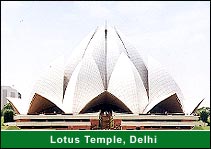 Day
01 : Delhi
Day
01 : Delhi
Company representatives will receive you on arrival at the international airport in Delhi late in the night or midnight. Transfer to your hotel.Relax.
DELHI, the capital of kingdoms and empires is now a sprawling metropolis with a fascinating blend of the past and the present. It is a perfect introduction to the composite culture of an ancient land. A window to the kaleidoscope - that is India.
Proceed to explore OLD DELHI.
OLD DELHI - A sightseeing tour of Old Delhi would entail visiting the Raj Ghat - the memorial site where Mahatma Gandhi was cremated; Jama Masjid - the largest mosque in India and the Red Fort - once the most opulent fort and palace of the Moghul Empire.
Enjoy the CYCLE RICKSHAW RIDE in the streets of Old Delhi. Retire early for the day.
Overnight will be at Delhi.
Day 02 : Delhi - Corbett National Park
By Road : 250 km in 6 hr
Breakfast will be at hotel.
Drive to CORBETT National Park.
JIM CORBETT National Park - One of the greatest National Parks of Asia. Corbett is five hundred and twenty acres of forests, hills and grasslands, fed by a frisky river - A bio-diversity that is rich, rare and precious. This Park is the perfect habitat for the tiger, elephant, hog deer, birds and other wildlife species that is fast vanishing from the earth.
JIM CORBETT t made his mark in his early life as a soldier and a hunter but subsequently, dedicated him to the preservation of life - human and wild. Whenever a man-eater threatened a village, ‘Carpet Sahib' was summoned. Moving on foot for days and weeks, often on steep winding trails, Corbett became the savior of the simple hill folk of Kumaon and Garhwal.
Jim Corbett could read the jungle signs like an open book. He could decipher a ripple in the dust of a dry streambed. A blade of grass caught in the act of springing back from a crushed position. When stalking, he could use the wind like predators do, to either conceal or reveal his presence. He could freeze stock-still in mid stride for any amount of time, just like an animal. He could easily read the sounds of the animals and could imitate them to perfection. Even the call of a tiger! With no assistance apart from his vocal chords, he could lure the animal to a face to face meeting. Two man-eaters shot by him were cornered using this awesome ability. Jim Corbett, the eighth child of a postmaster, gave up on academics early, proved his prowess at the gun at the age of 8. He worked as storekeeper, labor contractor, Captain in World War I, member of municipal board, and trained soldiers in jungle warfare for World War II, was awarded the rank of Lieutenant Colonel. He shot with his camera and chronicled his experiences in 8 gripping books.
Check in at the resort and relax. Proceed for an afternoon jungle safari for game viewing.
Relax in the evening at the resort restaurant. Overnight will be at resort.
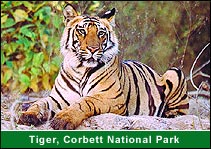 Day
03 : Corbett National Park
Day
03 : Corbett National Park
Enjoy a full day game viewing inside the jungle. (Two safaris)
Overnight will be at the resort.
Day 04 : Corbett - Delhi
By Road : 250 km in 6 hr
Breakfast will be at hotel.
Proceed for a morning game-drive into the forest.
Drive to Delhi in the afternoon. Reach and relax.
Spend night at Delhi.
Day 05 : Delhi - Ranthambore
By Train : 400 km in 6 hr
Transfer to the station for train to SAWAI MADHOPUR after breakfast.
Reach and transfer to the resort. Evening free at the resort and you can relax or watch some slides on the tiger.
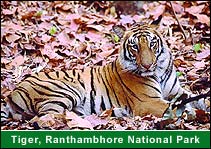 Ranthambhore
Tiger Reserve, at the junction of the Aravalis and the Vindhyas, is a unique
example of natural and historical richness, standing out conspicuously in the
vast, arid and denuded tract of eastern Rajasthan, barely 14 kilometers from
Sawai Madhopur. Get in tune with nature for a luxury holiday in the heart of
the jungle. Ranthambhore <the_town.html> - perhaps the best place in the
world to sight a tiger in the wild. The Ranthambhore National Park <the_sanctuary.html>
has had more Tiger sightings than any other National Park in the country. It
has come to be known as "The land of the Tiger", where most of the
documented footage of this majestic beast has been recorded.
Ranthambhore
Tiger Reserve, at the junction of the Aravalis and the Vindhyas, is a unique
example of natural and historical richness, standing out conspicuously in the
vast, arid and denuded tract of eastern Rajasthan, barely 14 kilometers from
Sawai Madhopur. Get in tune with nature for a luxury holiday in the heart of
the jungle. Ranthambhore <the_town.html> - perhaps the best place in the
world to sight a tiger in the wild. The Ranthambhore National Park <the_sanctuary.html>
has had more Tiger sightings than any other National Park in the country. It
has come to be known as "The land of the Tiger", where most of the
documented footage of this majestic beast has been recorded.
It spreads over a highly undulating topography varying from gentle to steep slopes; from flat topped hills of the Vindhyas to the conical hillocks and sharp ridges of the Aravalis, from wide and flat valleys to narrow rocky gorges. An important geological feature the ‘Great Boundary Fault’ where the Vindhya plateaus meet the Aravali hill ranges, meanders through the Reserve. The National Park is bound by the rivers Chambal in the south and Banas in the north.
Ranthambhore forest is of tropical dry deciduous type, further classified as Dhok climax forest because of the predominance of Dhok (Anogeissus pendulla) found nearly everywhere. Dhok is an extremely hardy tree, capable of withstanding prolonged droughts. The leaves of this tree are good fodder and they are browsed by herbivores, and form a significant part of their diet. Even the dry, fallen leaves, eaten by them, are rich source of nutrition.
Palas or Cheela or the Flame of the Forest (Butea monosperms) blooms magnificently around mid-April. During the period, Kachida and Anatpura provide an amazing view, like a forest on fire. Around Kamaldhar massive Gum trees (Sterculia urens) with smooth white trunk stand out conspicuously. Similarly, Gurjan (Lannea coromandelica) with greyish trunks at the banks of the lakes and soft wood Salar (Boswellia serrata) dotted atop hills are noticeable.
The lakes abound with aquatic vegetation including duck weeds, lilies and lotus. A haven for a multitude of wild animals, the Park boasts of playing host to tigers, leopards, the elusive caracals, hyenas, sloth bears, wild boars, crocodiles and so on. Besides, there are over 300 species of birds, from the majestic Crested Serpent Eagle to the exotic Golden Oriole.
Tiger, at the apex of the food chain, lord over the kingdom in a subtle way. Solitary by nature, it operates in stealth. Therefore tiger sightings, frequent as they are, are always a matter of chance. However, even evidences of tiger's activities are very exciting.
The other kinds of cats found in Ranthambhore are Leopard (Panthera pardus), Caracal (Felis caracal), Leopard Cat (Felis bengalensis), Fishing Cat (Felis viverrina) and the Jungle Cat (Felis chaus). Besides the big cats, the other large predators found in Ranthambhore include Sloth Bear, Striped Hyena, Wolf, Wild dog (or Dhole), Jackal, Indian Fox, Palm Civet, Small Indian Civet, Common Indian Mongoose, Small Indian Mongoose, Ratel (or Honey Badger), Marsh Crocodile and the Indian Python.
Overnight will be at resort.
Day 06 : Ranthambore
Enjoy a full day game viewing inside the jungle. (Two safaris) Overnight will be at the resort.
Day 07 : Ranthambore
Enjoy a full day game viewing inside the jungle. (Two safaris) Overnight will be at the resort.
Day 08 : Ranthambore - Bharatpur
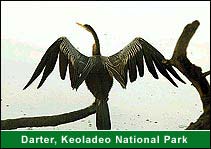 Keoladeo
Ghana National Park
Keoladeo
Ghana National Park
By Road : 400 km in 6 hr
Proceed to Bharatpur after the early morning game drive and breakfast.
Just 176 km from Delhi is a very special wilderness - the Keoladeo Ghana National Park, one of the finest water-bird sanctuaries in the world. The Maharaja of Bharatpur artificially created the lake and wetland in the 19th century. By building small dykes and dams and diverting water from an irrigation canal, he converted this low-lying area into a fine wild fowl shooting preserve. In a few years, the new wetland surrounded by marginal forests was able to support thousands of water birds.
Commonly referred to as Bharatpur, the Park is a delight for bird watchers. Over 375 species of birds are found here and raised paths, camouflaged by babul trees and undergrowth make viewing easy. A quiet ride by boat in the early hours of the morning is also unforgettable experience. The cacophony is unbelievable as painted storks, open bills, spoonbills, egrets, cormorants, white ibis and multitudes of others, tend their young. Jacanas with their iridescent colors and elegant tail feathers and purple moorhen can be seen delicately treading over the floating vegetation.
Every year Bharatpur waits with bated breath for the arrival of the Siberian cranes. There are only two wintering places for this rare species one in Iran and the other Bharatpur and these beautiful birds with their distinctive red beaks and facial patches, fly over 6400 km from their summer retreats.
Colorful kingfishers, graceful pelicans rare Siberian cranes and Trans- continental fliers - the migratory water - fowl are amongst the 375 species of birds found in the Keoladeo National Park. The most spectacular nesting is that of the egrets, storks, herons and cormorants, which make over 10,000 nests every year. This makes outstanding bird havens of the world. The park covers an area of 28.73km.
The story of Bharatpur Bird Sanctuary is incomplete without an account of the migratory waterfowl. The most prominent waterfowl coming to this park are bareheaded and greyleg geese. Ducks also create a lot of fluttering in the lakes. The ducks usually found here are pintail, widgeon, common shelduck, shoveler, garganey, teal, etc.
Attracted by the influx of the waterfowl the predatory birds-tawny eagles, spotted eagles short-toed eagles imperial eagles and fishing eagle also arrive. They all form the apex of the biological pyramid of the sanctuary and complete the avian food chain of the ecosystem. There are large herds of the nilgai, chital, wild boar and fear cows in addition to a few herds of sambar.
Reach and check in at the hotel. Proceed on RICKSHAW for viewing the birds. RICKSHAW PULLERS have been trained by the forest department in bird watching and are knowledgeable.
Return to the lodge in the evening and relax. Overnight will be at Bharatpur.
Day 09 : Bharatpur - Agra
By Road : 55 km in 1 hr
Breakfast will be at the hotel. Enjoy the early morning RICKSHAW RIDE at the Bird Park.
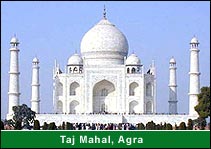 Drive
to Agra.
Drive
to Agra.
Reach Fatehpur Sikri after a light lunch break. The deserted, red Sandstone City, Emperor Akbar built that as his capital and palace in the late 16th century is an exhilarating experience. It a veritable fairytale city and its "ruins" are in pristine condition ... it's not hard to imagine what the court life must have been like in the days of its grandeur. Also visit the Bulund Darwaza, the largest gateway in the world.
Continue towards Agra and reach by evening. Check in at hotel.
AGRA: Two great Mughal monarchs, Akbar and Shah Jahan, transformed the little village of Agra into a befitting second capital of the Mughal Empire - giving it the name Dar-ul-Khilafat {seat of the Emperor}. Today a visitor to Agra is caught up in a world of contrasting edifices, of red sandstone and white marble, narrow galleys and quaint buggies, and that irresistible charm that this favorite city of the Mughals still retains. It is not surprising, that modern Agra still reflects its Mughal heritage most conspicuously. A walk down the narrow bustling streets of the city will introduce the visitor to the wafting aroma of Mughlai cuisine.
Overnight stay will be at Agra.
Day 10 : Agra - Umaria (Bandavgarh)
By Overnight train at 1800 hr
Proceed to visit Taj after breakfast. Enjoy battery van ride to the Taj.
TAJ MAHAL: Little needs to be said about this architectural wonder which is always the soul raison-de-etre for every tourist's visit to Agra. Built by Shah Jahan, the Taj is a white marble memorial to his beautiful wife Mumtaz Mahal. This monument took 22 years to be completed and was designed, and planned by Persian architect Ustad Isa. Apart from its stunning design balance and perfect symmetry, the Taj is also noted particularly for its elegant domes, intricately carved screens and some of the best inlay work ever seen.
Proceed for sightseeing to the AGRA FORT - Built by the famed Mughal emperor Akbar in 1565 AD, the fort is predominantly of red sandstone. Ensconced within is the picture perfect Pearl Mosque, which is a major tourist attraction.
Visit Itmadullah’s Tomb built by Empress NOOR JEHAN in memory of her father (The interiors of which are considered better than the Taj).
Proceed to station for train to UMARIA. Overnight will be on train.
Day 11 : Bandavgarh
Arrive in the morning at 0600 hr
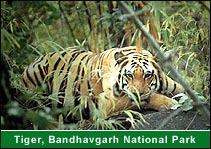
Reach Umaria early in the morning. Drive to Bandavgarh. Enjoy breakfast at the resort and relax during the morning as the train journey is tiring.
Bandavgarh is a new National Park with a very long history. Set among the Vindhya hills of Madhya Pradesh with an area of 168sq miles (437sq km) it contains a wide variety of habitats and a high density of game, including a large number of Tigers. This is also the White tiger country. These have been found in the old state of Rewa for Many years. Maharaja Martand Singh captured the last known in 1951. This white Tiger, Mohun is now stuffed and on display in the Palace of Maharaja of Rewa. Prior to becoming a National Park, the forests around Bandavgarh had long been maintained as a Shikargah, or game preserve of the Maharaja of Rewa. The Maharaja and his guests carried out hunting - otherwise the wildlife was well protected. It was considered a good omen for Maharaja of Rewa to shoot 109 tigers. His Highness Maharaja Venkat Raman Singh shot 111 Tigers by 1914.
There are 32 hills in this part of the park, which has a large natural fort at its center. The fort’s cliffs are 2625 feet (800 meters) high, 1000 feet (300 meters) above the surrounding countryside.
Bandavgarh has been a center of human activity and settlement for over 2000 years, and there are references to it in the ancient books, the Narad-Panch Ratra and the Shiva Purana. Legend has it that Lord Rama, hero of the Hindu epic, the Ramayana, stopped at Bandavgarh on his way back to his homeland after defeating the demon King Ravana of Lanka. Two monkey architects, who had engineered a bridge between the isle of Lanka and the mainland, are said to have built Bandavgarh’s Fort. Later Rama handed it over to his brother Lakshmana who became known as Bandavdhish “The Lord of the Fort”. Lakshmana is the particular God of the fort and is regularly worshipped in a temple there.
The oldest sign of habitation in the park are caves dug into the sandstone to the north of the fort. Several contain Brahmi inscriptions dating from the 1st century BC. Various dynasties have ruled the fort, for example, the Maghas from the 1st century AD, the Vakatakas from the 3rd century AD, From that time onwards Bandavgarh was ruled by a succession of dynasties including the Chandela Kings of Bundelkhand who built the famous temples at Khajuraho. The Baghel Kings, the direct ancestors of the present Royal family of Rewa, established their dynasty at Bandavgarh in the 12th century. It remained their capital till 1617 when the center of court life moved to Rewa, 75 miles (120Kms) to the north. Without royal patronage Bandavgarh became more and more deserted until forest overran the area and it became the royal hunting reserve. This helped to preserve the forest and its wildlife, although the Maharajas made full use of their rights. Each set out to kill the auspicious number of 109 Tigers.
In the afternoon proceed for a GAME SAFARI into the park. Overnight will be at Bandavgarh.
Day 12 : Bandavgarh
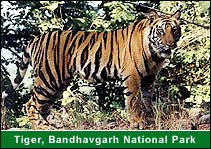
Enjoy a full day game viewing inside the jungle. (Two safaris)
Trip to the Bandavgarh Fort: The oldest fort in India - considered to be more than 2500 years. One-hour trek up the fort is worth the effort. The charm of this trek lies in discovering these monuments in the jungle, unspoiled and unexplored. Some of the statues lie off the main path and so it is best to take a guide. Apart from the avatars, well worth seeing are three small temples of around the 12th century. These temples are deserted but the fort is still used as a place of worship. Kabir Das, the celebrated 16th century saint, once lived and preached here. The natural ramparts of the fort give breathtaking view of the surrounding countryside. The fort still belongs to the Maharaja of Rewa and permission is required to visit it. However permission is available locally and no trip to Bandhavgarh is complete without making an effort to climb up the fort. The staff of the resort carries your lunch while you are busy negotiating the trek to the fort.
Overnight will be at the resort.
Day 13 : Bandavgarh
Enjoy a full day game viewing inside the jungle. (Two safaris) Overnight will be at the resort.
Day 14 : Bandavgarh - Kanha
By Road : 255 km in 6 hr
Enjoy the morning safari in the park.
After breakfast drive to Kanha.
This is the place that has been described by RUDYARD KIPLING in his great book "The Jungle Book". Located in the Mandla district of Madhya Pradesh, Kanha National Park is a tiger reserve that extends over an area of over 940 square km. A horseshoe shaped valley bounded by the spurs of the Mekal presents an interesting topography. Steep rocky escarpments along the edges offer breathtaking views of the valley. Realizing the danger on the Tiger population in the country, the Government started the "Project Tiger" at Kanha and in 1974 the area was declared a Tiger reserve. The park is also the habitat of the high ground Barasingha.
In 1930s, the Kanha area was divided into two sanctuaries - Hallon and Banjar of 250kms to 300kms each. Though one of these was subsequently disbanded .The area remained a protected one until 1947. Depletion of the tiger population in the year that followed led to the area being made an absolute sanctuary in 1952.
Patient watching should reward the visitor, with a sight of Indian Fox, Sloth bear, Striped hyena, Jungle cut, Lepord, Mouse Deer, Chausingha or four horned antelope, Nilgai, Ratel and Porcupine Kanha has some 200 species of birds. Watchers should station themselves in the hills, where the mixed and bamboo forests harbour many species and in the grassy forest clearings. Water birds can be seen near the park’s many rivulets and at Sarvantal, a pool that is frequented by water birds and the area in front of the museum.
Excursion to Kawardha just east of the Maikala Range (up to 1100m) to the south east of Kanha National Park, Kawardha is a small town in Chhattisgarh (34 forts) region of M.P. In this remote area Maharaja Viswaraj Singh has recently opened his palace to visitors. It provides a delightfully quite unspoiled contrast with India’s big cities and with the much busier tourist circuit of Rajasthan’s ‘palace circuit’. This town is in the center of the Baiga tribe, who live in forest surrounding the town, and these are several eleventh century temples in the immediate region.
Reach in the afternoon and relax at the resort.
Overnight will be at the resort.
Day 15 : Kanha
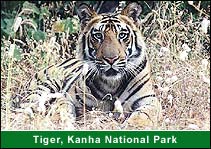 Enjoy
a full day game viewing inside the jungle. (Two safaris)
Enjoy
a full day game viewing inside the jungle. (Two safaris)
Overnight will be at the resort.
Day 16 : Kanha - Nagpur
By Road : 255 km in 6 hr
Proceed for the morning safari into forest.
Start for Nagpur after lunch. Reach and check in at hotel. Dinner will be served in the hotel.
Overnight will be in the hotel.
Day 17 : Nagpur - Delhi
Arrive at Delhi in the morning.
Check in at hotel, relax and then start NEW DELHI sightseeing after lunch.
NEW DELHI - A sightseeing tour of New Delhi would include a visit to the Humayun’s Tomb, the Qutub Minar, a drive along the ceremonial avenue - Rajpath, past the imposing India Gate, Parliament House and the President’s Residence and would end with a drive through the Diplomatic Enclave.
Proceed to the airport for flight home as per timing.
TOUR ENDS
Extensive Tiger Tour of North India
Duration : 16 Nights & 17 Days
Destination Covered : Delhi - Corbett - Delhi - Ranthambore - Bharatpur - Agra - Umaria - Bandavgarh - Kanha - Nagpur - Delhi
 Day
01 : Delhi
Day
01 : DelhiCompany representatives will receive you on arrival at the international airport in Delhi late in the night or midnight. Transfer to your hotel.Relax.
DELHI, the capital of kingdoms and empires is now a sprawling metropolis with a fascinating blend of the past and the present. It is a perfect introduction to the composite culture of an ancient land. A window to the kaleidoscope - that is India.
Proceed to explore OLD DELHI.
OLD DELHI - A sightseeing tour of Old Delhi would entail visiting the Raj Ghat - the memorial site where Mahatma Gandhi was cremated; Jama Masjid - the largest mosque in India and the Red Fort - once the most opulent fort and palace of the Moghul Empire.
Enjoy the CYCLE RICKSHAW RIDE in the streets of Old Delhi. Retire early for the day.
Overnight will be at Delhi.
Day 02 : Delhi - Corbett National Park
By Road : 250 km in 6 hr
Breakfast will be at hotel.
Drive to CORBETT National Park.
JIM CORBETT National Park - One of the greatest National Parks of Asia. Corbett is five hundred and twenty acres of forests, hills and grasslands, fed by a frisky river - A bio-diversity that is rich, rare and precious. This Park is the perfect habitat for the tiger, elephant, hog deer, birds and other wildlife species that is fast vanishing from the earth.
JIM CORBETT t made his mark in his early life as a soldier and a hunter but subsequently, dedicated him to the preservation of life - human and wild. Whenever a man-eater threatened a village, ‘Carpet Sahib' was summoned. Moving on foot for days and weeks, often on steep winding trails, Corbett became the savior of the simple hill folk of Kumaon and Garhwal.
Jim Corbett could read the jungle signs like an open book. He could decipher a ripple in the dust of a dry streambed. A blade of grass caught in the act of springing back from a crushed position. When stalking, he could use the wind like predators do, to either conceal or reveal his presence. He could freeze stock-still in mid stride for any amount of time, just like an animal. He could easily read the sounds of the animals and could imitate them to perfection. Even the call of a tiger! With no assistance apart from his vocal chords, he could lure the animal to a face to face meeting. Two man-eaters shot by him were cornered using this awesome ability. Jim Corbett, the eighth child of a postmaster, gave up on academics early, proved his prowess at the gun at the age of 8. He worked as storekeeper, labor contractor, Captain in World War I, member of municipal board, and trained soldiers in jungle warfare for World War II, was awarded the rank of Lieutenant Colonel. He shot with his camera and chronicled his experiences in 8 gripping books.
Check in at the resort and relax. Proceed for an afternoon jungle safari for game viewing.
Relax in the evening at the resort restaurant. Overnight will be at resort.
 Day
03 : Corbett National Park
Day
03 : Corbett National ParkEnjoy a full day game viewing inside the jungle. (Two safaris)
Overnight will be at the resort.
Day 04 : Corbett - Delhi
By Road : 250 km in 6 hr
Breakfast will be at hotel.
Proceed for a morning game-drive into the forest.
Drive to Delhi in the afternoon. Reach and relax.
Spend night at Delhi.
Day 05 : Delhi - Ranthambore
By Train : 400 km in 6 hr
Transfer to the station for train to SAWAI MADHOPUR after breakfast.
Reach and transfer to the resort. Evening free at the resort and you can relax or watch some slides on the tiger.
 Ranthambhore
Tiger Reserve, at the junction of the Aravalis and the Vindhyas, is a unique
example of natural and historical richness, standing out conspicuously in the
vast, arid and denuded tract of eastern Rajasthan, barely 14 kilometers from
Sawai Madhopur. Get in tune with nature for a luxury holiday in the heart of
the jungle. Ranthambhore <the_town.html> - perhaps the best place in the
world to sight a tiger in the wild. The Ranthambhore National Park <the_sanctuary.html>
has had more Tiger sightings than any other National Park in the country. It
has come to be known as "The land of the Tiger", where most of the
documented footage of this majestic beast has been recorded.
Ranthambhore
Tiger Reserve, at the junction of the Aravalis and the Vindhyas, is a unique
example of natural and historical richness, standing out conspicuously in the
vast, arid and denuded tract of eastern Rajasthan, barely 14 kilometers from
Sawai Madhopur. Get in tune with nature for a luxury holiday in the heart of
the jungle. Ranthambhore <the_town.html> - perhaps the best place in the
world to sight a tiger in the wild. The Ranthambhore National Park <the_sanctuary.html>
has had more Tiger sightings than any other National Park in the country. It
has come to be known as "The land of the Tiger", where most of the
documented footage of this majestic beast has been recorded. It spreads over a highly undulating topography varying from gentle to steep slopes; from flat topped hills of the Vindhyas to the conical hillocks and sharp ridges of the Aravalis, from wide and flat valleys to narrow rocky gorges. An important geological feature the ‘Great Boundary Fault’ where the Vindhya plateaus meet the Aravali hill ranges, meanders through the Reserve. The National Park is bound by the rivers Chambal in the south and Banas in the north.
Ranthambhore forest is of tropical dry deciduous type, further classified as Dhok climax forest because of the predominance of Dhok (Anogeissus pendulla) found nearly everywhere. Dhok is an extremely hardy tree, capable of withstanding prolonged droughts. The leaves of this tree are good fodder and they are browsed by herbivores, and form a significant part of their diet. Even the dry, fallen leaves, eaten by them, are rich source of nutrition.
Palas or Cheela or the Flame of the Forest (Butea monosperms) blooms magnificently around mid-April. During the period, Kachida and Anatpura provide an amazing view, like a forest on fire. Around Kamaldhar massive Gum trees (Sterculia urens) with smooth white trunk stand out conspicuously. Similarly, Gurjan (Lannea coromandelica) with greyish trunks at the banks of the lakes and soft wood Salar (Boswellia serrata) dotted atop hills are noticeable.
The lakes abound with aquatic vegetation including duck weeds, lilies and lotus. A haven for a multitude of wild animals, the Park boasts of playing host to tigers, leopards, the elusive caracals, hyenas, sloth bears, wild boars, crocodiles and so on. Besides, there are over 300 species of birds, from the majestic Crested Serpent Eagle to the exotic Golden Oriole.
Tiger, at the apex of the food chain, lord over the kingdom in a subtle way. Solitary by nature, it operates in stealth. Therefore tiger sightings, frequent as they are, are always a matter of chance. However, even evidences of tiger's activities are very exciting.
The other kinds of cats found in Ranthambhore are Leopard (Panthera pardus), Caracal (Felis caracal), Leopard Cat (Felis bengalensis), Fishing Cat (Felis viverrina) and the Jungle Cat (Felis chaus). Besides the big cats, the other large predators found in Ranthambhore include Sloth Bear, Striped Hyena, Wolf, Wild dog (or Dhole), Jackal, Indian Fox, Palm Civet, Small Indian Civet, Common Indian Mongoose, Small Indian Mongoose, Ratel (or Honey Badger), Marsh Crocodile and the Indian Python.
Overnight will be at resort.
Day 06 : Ranthambore
Enjoy a full day game viewing inside the jungle. (Two safaris) Overnight will be at the resort.
Day 07 : Ranthambore
Enjoy a full day game viewing inside the jungle. (Two safaris) Overnight will be at the resort.
Day 08 : Ranthambore - Bharatpur
 Keoladeo
Ghana National Park
Keoladeo
Ghana National ParkBy Road : 400 km in 6 hr
Proceed to Bharatpur after the early morning game drive and breakfast.
Just 176 km from Delhi is a very special wilderness - the Keoladeo Ghana National Park, one of the finest water-bird sanctuaries in the world. The Maharaja of Bharatpur artificially created the lake and wetland in the 19th century. By building small dykes and dams and diverting water from an irrigation canal, he converted this low-lying area into a fine wild fowl shooting preserve. In a few years, the new wetland surrounded by marginal forests was able to support thousands of water birds.
Commonly referred to as Bharatpur, the Park is a delight for bird watchers. Over 375 species of birds are found here and raised paths, camouflaged by babul trees and undergrowth make viewing easy. A quiet ride by boat in the early hours of the morning is also unforgettable experience. The cacophony is unbelievable as painted storks, open bills, spoonbills, egrets, cormorants, white ibis and multitudes of others, tend their young. Jacanas with their iridescent colors and elegant tail feathers and purple moorhen can be seen delicately treading over the floating vegetation.
Every year Bharatpur waits with bated breath for the arrival of the Siberian cranes. There are only two wintering places for this rare species one in Iran and the other Bharatpur and these beautiful birds with their distinctive red beaks and facial patches, fly over 6400 km from their summer retreats.
Colorful kingfishers, graceful pelicans rare Siberian cranes and Trans- continental fliers - the migratory water - fowl are amongst the 375 species of birds found in the Keoladeo National Park. The most spectacular nesting is that of the egrets, storks, herons and cormorants, which make over 10,000 nests every year. This makes outstanding bird havens of the world. The park covers an area of 28.73km.
The story of Bharatpur Bird Sanctuary is incomplete without an account of the migratory waterfowl. The most prominent waterfowl coming to this park are bareheaded and greyleg geese. Ducks also create a lot of fluttering in the lakes. The ducks usually found here are pintail, widgeon, common shelduck, shoveler, garganey, teal, etc.
Attracted by the influx of the waterfowl the predatory birds-tawny eagles, spotted eagles short-toed eagles imperial eagles and fishing eagle also arrive. They all form the apex of the biological pyramid of the sanctuary and complete the avian food chain of the ecosystem. There are large herds of the nilgai, chital, wild boar and fear cows in addition to a few herds of sambar.
Reach and check in at the hotel. Proceed on RICKSHAW for viewing the birds. RICKSHAW PULLERS have been trained by the forest department in bird watching and are knowledgeable.
Return to the lodge in the evening and relax. Overnight will be at Bharatpur.
Day 09 : Bharatpur - Agra
By Road : 55 km in 1 hr
Breakfast will be at the hotel. Enjoy the early morning RICKSHAW RIDE at the Bird Park.
 Drive
to Agra.
Drive
to Agra. Reach Fatehpur Sikri after a light lunch break. The deserted, red Sandstone City, Emperor Akbar built that as his capital and palace in the late 16th century is an exhilarating experience. It a veritable fairytale city and its "ruins" are in pristine condition ... it's not hard to imagine what the court life must have been like in the days of its grandeur. Also visit the Bulund Darwaza, the largest gateway in the world.
Continue towards Agra and reach by evening. Check in at hotel.
AGRA: Two great Mughal monarchs, Akbar and Shah Jahan, transformed the little village of Agra into a befitting second capital of the Mughal Empire - giving it the name Dar-ul-Khilafat {seat of the Emperor}. Today a visitor to Agra is caught up in a world of contrasting edifices, of red sandstone and white marble, narrow galleys and quaint buggies, and that irresistible charm that this favorite city of the Mughals still retains. It is not surprising, that modern Agra still reflects its Mughal heritage most conspicuously. A walk down the narrow bustling streets of the city will introduce the visitor to the wafting aroma of Mughlai cuisine.
Overnight stay will be at Agra.
Day 10 : Agra - Umaria (Bandavgarh)
By Overnight train at 1800 hr
Proceed to visit Taj after breakfast. Enjoy battery van ride to the Taj.
TAJ MAHAL: Little needs to be said about this architectural wonder which is always the soul raison-de-etre for every tourist's visit to Agra. Built by Shah Jahan, the Taj is a white marble memorial to his beautiful wife Mumtaz Mahal. This monument took 22 years to be completed and was designed, and planned by Persian architect Ustad Isa. Apart from its stunning design balance and perfect symmetry, the Taj is also noted particularly for its elegant domes, intricately carved screens and some of the best inlay work ever seen.
Proceed for sightseeing to the AGRA FORT - Built by the famed Mughal emperor Akbar in 1565 AD, the fort is predominantly of red sandstone. Ensconced within is the picture perfect Pearl Mosque, which is a major tourist attraction.
Visit Itmadullah’s Tomb built by Empress NOOR JEHAN in memory of her father (The interiors of which are considered better than the Taj).
Proceed to station for train to UMARIA. Overnight will be on train.
Day 11 : Bandavgarh
Arrive in the morning at 0600 hr

Reach Umaria early in the morning. Drive to Bandavgarh. Enjoy breakfast at the resort and relax during the morning as the train journey is tiring.
Bandavgarh is a new National Park with a very long history. Set among the Vindhya hills of Madhya Pradesh with an area of 168sq miles (437sq km) it contains a wide variety of habitats and a high density of game, including a large number of Tigers. This is also the White tiger country. These have been found in the old state of Rewa for Many years. Maharaja Martand Singh captured the last known in 1951. This white Tiger, Mohun is now stuffed and on display in the Palace of Maharaja of Rewa. Prior to becoming a National Park, the forests around Bandavgarh had long been maintained as a Shikargah, or game preserve of the Maharaja of Rewa. The Maharaja and his guests carried out hunting - otherwise the wildlife was well protected. It was considered a good omen for Maharaja of Rewa to shoot 109 tigers. His Highness Maharaja Venkat Raman Singh shot 111 Tigers by 1914.
There are 32 hills in this part of the park, which has a large natural fort at its center. The fort’s cliffs are 2625 feet (800 meters) high, 1000 feet (300 meters) above the surrounding countryside.
Bandavgarh has been a center of human activity and settlement for over 2000 years, and there are references to it in the ancient books, the Narad-Panch Ratra and the Shiva Purana. Legend has it that Lord Rama, hero of the Hindu epic, the Ramayana, stopped at Bandavgarh on his way back to his homeland after defeating the demon King Ravana of Lanka. Two monkey architects, who had engineered a bridge between the isle of Lanka and the mainland, are said to have built Bandavgarh’s Fort. Later Rama handed it over to his brother Lakshmana who became known as Bandavdhish “The Lord of the Fort”. Lakshmana is the particular God of the fort and is regularly worshipped in a temple there.
The oldest sign of habitation in the park are caves dug into the sandstone to the north of the fort. Several contain Brahmi inscriptions dating from the 1st century BC. Various dynasties have ruled the fort, for example, the Maghas from the 1st century AD, the Vakatakas from the 3rd century AD, From that time onwards Bandavgarh was ruled by a succession of dynasties including the Chandela Kings of Bundelkhand who built the famous temples at Khajuraho. The Baghel Kings, the direct ancestors of the present Royal family of Rewa, established their dynasty at Bandavgarh in the 12th century. It remained their capital till 1617 when the center of court life moved to Rewa, 75 miles (120Kms) to the north. Without royal patronage Bandavgarh became more and more deserted until forest overran the area and it became the royal hunting reserve. This helped to preserve the forest and its wildlife, although the Maharajas made full use of their rights. Each set out to kill the auspicious number of 109 Tigers.
In the afternoon proceed for a GAME SAFARI into the park. Overnight will be at Bandavgarh.
Day 12 : Bandavgarh

Enjoy a full day game viewing inside the jungle. (Two safaris)
Trip to the Bandavgarh Fort: The oldest fort in India - considered to be more than 2500 years. One-hour trek up the fort is worth the effort. The charm of this trek lies in discovering these monuments in the jungle, unspoiled and unexplored. Some of the statues lie off the main path and so it is best to take a guide. Apart from the avatars, well worth seeing are three small temples of around the 12th century. These temples are deserted but the fort is still used as a place of worship. Kabir Das, the celebrated 16th century saint, once lived and preached here. The natural ramparts of the fort give breathtaking view of the surrounding countryside. The fort still belongs to the Maharaja of Rewa and permission is required to visit it. However permission is available locally and no trip to Bandhavgarh is complete without making an effort to climb up the fort. The staff of the resort carries your lunch while you are busy negotiating the trek to the fort.
Overnight will be at the resort.
Day 13 : Bandavgarh
Enjoy a full day game viewing inside the jungle. (Two safaris) Overnight will be at the resort.
Day 14 : Bandavgarh - Kanha
By Road : 255 km in 6 hr
Enjoy the morning safari in the park.
After breakfast drive to Kanha.
This is the place that has been described by RUDYARD KIPLING in his great book "The Jungle Book". Located in the Mandla district of Madhya Pradesh, Kanha National Park is a tiger reserve that extends over an area of over 940 square km. A horseshoe shaped valley bounded by the spurs of the Mekal presents an interesting topography. Steep rocky escarpments along the edges offer breathtaking views of the valley. Realizing the danger on the Tiger population in the country, the Government started the "Project Tiger" at Kanha and in 1974 the area was declared a Tiger reserve. The park is also the habitat of the high ground Barasingha.
In 1930s, the Kanha area was divided into two sanctuaries - Hallon and Banjar of 250kms to 300kms each. Though one of these was subsequently disbanded .The area remained a protected one until 1947. Depletion of the tiger population in the year that followed led to the area being made an absolute sanctuary in 1952.
Patient watching should reward the visitor, with a sight of Indian Fox, Sloth bear, Striped hyena, Jungle cut, Lepord, Mouse Deer, Chausingha or four horned antelope, Nilgai, Ratel and Porcupine Kanha has some 200 species of birds. Watchers should station themselves in the hills, where the mixed and bamboo forests harbour many species and in the grassy forest clearings. Water birds can be seen near the park’s many rivulets and at Sarvantal, a pool that is frequented by water birds and the area in front of the museum.
Excursion to Kawardha just east of the Maikala Range (up to 1100m) to the south east of Kanha National Park, Kawardha is a small town in Chhattisgarh (34 forts) region of M.P. In this remote area Maharaja Viswaraj Singh has recently opened his palace to visitors. It provides a delightfully quite unspoiled contrast with India’s big cities and with the much busier tourist circuit of Rajasthan’s ‘palace circuit’. This town is in the center of the Baiga tribe, who live in forest surrounding the town, and these are several eleventh century temples in the immediate region.
Reach in the afternoon and relax at the resort.
Overnight will be at the resort.
Day 15 : Kanha
 Enjoy
a full day game viewing inside the jungle. (Two safaris)
Enjoy
a full day game viewing inside the jungle. (Two safaris) Overnight will be at the resort.
Day 16 : Kanha - Nagpur
By Road : 255 km in 6 hr
Proceed for the morning safari into forest.
Start for Nagpur after lunch. Reach and check in at hotel. Dinner will be served in the hotel.
Overnight will be in the hotel.
Day 17 : Nagpur - Delhi
Arrive at Delhi in the morning.
Check in at hotel, relax and then start NEW DELHI sightseeing after lunch.
NEW DELHI - A sightseeing tour of New Delhi would include a visit to the Humayun’s Tomb, the Qutub Minar, a drive along the ceremonial avenue - Rajpath, past the imposing India Gate, Parliament House and the President’s Residence and would end with a drive through the Diplomatic Enclave.
Proceed to the airport for flight home as per timing.
TOUR ENDS
Click here for Reservation / More Information
Wildlife Tours
India
Indian Wildlife Tour Wildlife
Tour of India and Nepal
Wildlife
Tour of India and Nepal  Tiger
Safari India
Tiger
Safari India  Extensive
Tiger Tour of North India
Extensive
Tiger Tour of North India
Tiger Safari with Taj Tiger and
Wild Dogs
Tiger and
Wild Dogs  Tiger and
Bird Tour
Tiger and
Bird Tour  Grand
Wildlife Tour of India and Nepal
Grand
Wildlife Tour of India and Nepal
Royal and Rustic Rajasthan with Wildlife Birding
Tour of North India
Birding
Tour of North India  Bamboo Rafting and
Elephant Bathing
Bamboo Rafting and
Elephant Bathing
Camel Safari in Rajasthan Wildlife Tour of Rajasthan
with Classical India
Wildlife Tour of Rajasthan
with Classical India  Wildlife
and Beaches of Kerala
Wildlife
and Beaches of Kerala
Classical India Tour with Wildlife Taj Tigers Tradition
Taj Tigers Tradition
 Tiger &
Birds Tours
Tiger &
Birds Tours  Birding
Tour India
Birding
Tour India
Wildlife & Adventure Wildlife
Tour Package
Wildlife
Tour Package  Elephant
Safari
Elephant
Safari  more...
more...
Indian Wildlife Tour
Tiger Safari with Taj
Royal and Rustic Rajasthan with Wildlife
Camel Safari in Rajasthan
Classical India Tour with Wildlife
Wildlife & Adventure
| Home | About Us | FAQ's | Contact Us | Commendations | Reservation |
| Copyright © Wildlife India Plus ( All Rights Reserved. ) | Web Development & SEO Services by |
